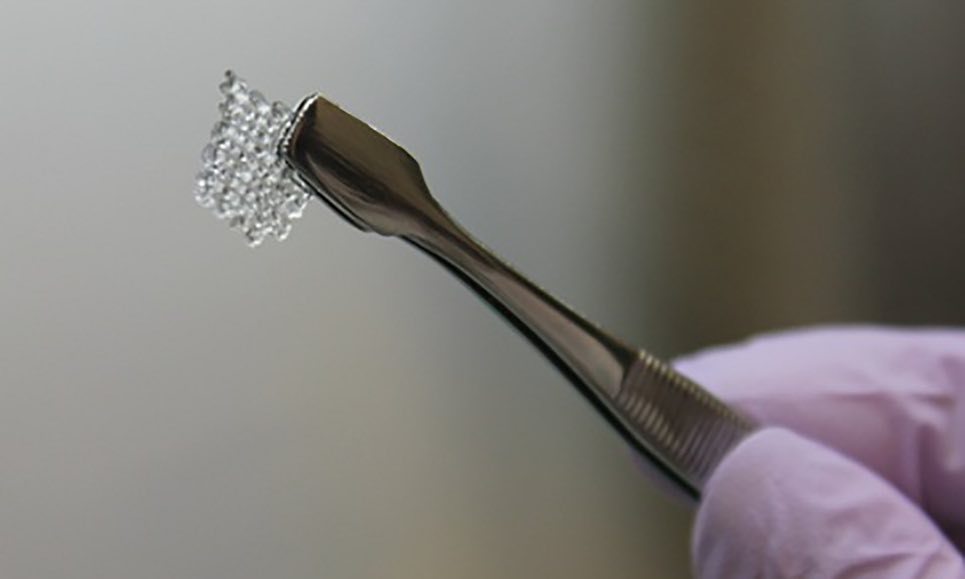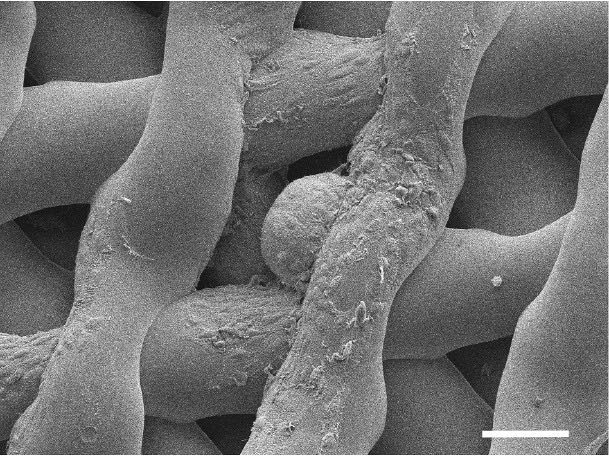3D printing of ovaries helped give birth to a sterile mouse

Scientists using 3D-printing developed a functioning ovaries, with which a sterile mouse was able to give birth to healthy mice. Ovarian bioprostheses consist of a porous gelatinous ink frame that is filled with follicles — tiny fluid bags containing bags of immature eggs. With their help, it was possible to increase the production of hormones and restore fertility in mice, which was the ultimate goal of the study.
In tests on mice in which one ovary was surgically removed, scientists found that implants were connected to the circulatory system for a week and continued to release eggs naturally through pores embedded in gelatinous structures. Of the seven mice that mated after the bioprosthesis was installed, three gave birth to healthy mice. Subsequently, they were able to eat their mother's milk and get healthy litters.
')
How does this work differ from other three-dimensional printed structures? First of all, it is the frame of the prosthesis and the material from which it was created. It is a gelatin - a biological hydrogel derived from destroyed collagen, which is safe for use in humans.
There are a number of conditions under which you can create a successful bioprosthesis that will not be rejected by a living organism. It must be made from organic materials that would be rigid enough to allow the bioprosthesis to be successfully implanted, but at the same time porous enough to naturally interact with the tissues of the mouse body.
Most hydrogels are very weak, as they consist mainly of water and often break down on their own. But researchers empirically calculated the temperature of gelatin, at which it does not collapse and is able to form several layers.
Three-dimensional printing was carried out by imposing fibers. In this way, it is possible to control the distance between the fibers, as well as the angle of advance between the layers, which allows the design of a prosthesis of various sizes and shapes. In the laboratory, researchers call these three-dimensional printed structures “scaffolding” and compare them with the scaffolding that surround the building during the renovation.
Ovarian bioprosthesis gratings were printed from gelatin plates. The size and position of the holes in the structures were carefully controlled so that dozens of follicles could be held and the blood vessels could be connected to the implants. Mature eggs are then released from the implants, as occurs during normal ovulation.

This ovarian geometry directly or indirectly organizes hormonal support for immature eggs, surrounding them. This is the first study that demonstrates that prosthetic architecture influences the survival of follicles. According to researchers, this could not be achieved without the use of three-dimensional printing.
A three-dimensional printed skeleton is implanted into a mouse, and its pores can be used to optimize the process of “wedging in” follicles or immature eggs in the skeleton. The prosthesis helps to survive the immature eggs and cells that produce hormones. The open structure also allows cells to mature, ovulate and form blood vessels inside the implant, thanks to which hormones circulate inside the mouse's circulatory system and trigger lactation after birth.
“Every organ has a“ skeleton ”. We learned how the “skeleton” of the ovary looked and used it as a model for the implantation of ovarian bioprostheses, ”said Teresa Woodruff, a professor of obstetrics and gynecology.
It is obvious that the printing of bioprostheses for mice is not the final stage of the study. Ovarian bioprosthetics should help restore fertility and hormone production in young women whose reproductive system has been damaged by cancer treatment. Often, these women ovaries cease to function properly, and patients require regular hormone replacement therapy.
Chemotherapy and high doses of radiation used in cancer treatment can destroy some or all of the eggs of women, putting them at risk for infertility and early menopause. And at a time when doctors have achieved some success in restoring fertility with the help of frozen ovarian tissue, the bioprosthesis can potentially help those for whom transplantation is not suitable, namely, very young girls and girls.
Research co-author Monica Laronda (Monica Laronda) noted that an ovarian bioprosthesis can help cancer patients whose ovaries are damaged so much that hormone therapy is required to start the process of puberty.
Scientists have previously created artificial ovaries for mice, but this is the first job that used 3D printing technology. However, it is not yet clear whether such an approach will be as effective for humans as it is for mice: human follicles are much larger and grow quickly until they are visible to the naked eye.
Other animal experiments conducted almost a decade ago hinted that women who had had their ovaries transplanted at a later age experienced not only fertility recovery, but also other positive effects. In 2010, scientists from the Kato Women's Clinic found that after ovarian transplantation, female mice live longer, and in humans this procedure encourages women of mature age, usually inactive, to look for their soulmate and have children. Researchers recognized that a lot of work would still need to be done to assess the impact on women.
Achievements of three-dimensional printing have already transformed some areas of medicine, allowing doctors to make parts that can be directly implanted in patients. In 2016, South Korean surgeons printed a titanium heel bone for a person who had a tumor removed.
Meanwhile, North Carolina researchers have announced that they have made ears, jaws, and skeletal muscles using three-dimensional printed structures filled with living cells. Other groups of scientists have printed vascular networks, which will be vital for creating large synthetic organs in the laboratory.
doi: 10.1038 / ncomms15261
Source: https://habr.com/ru/post/403979/
All Articles